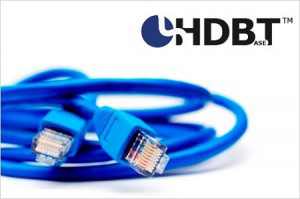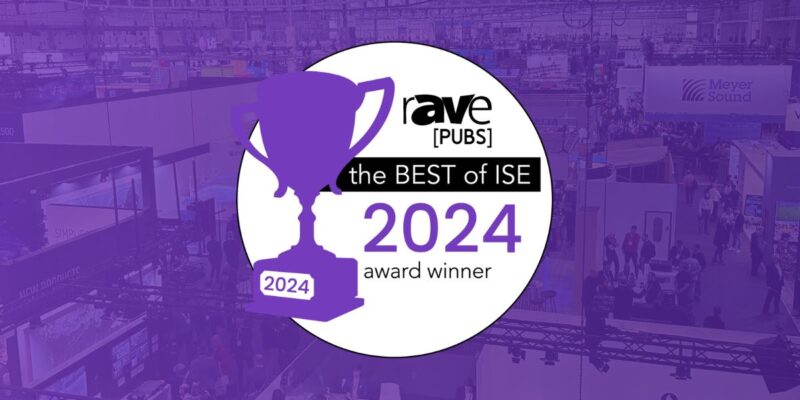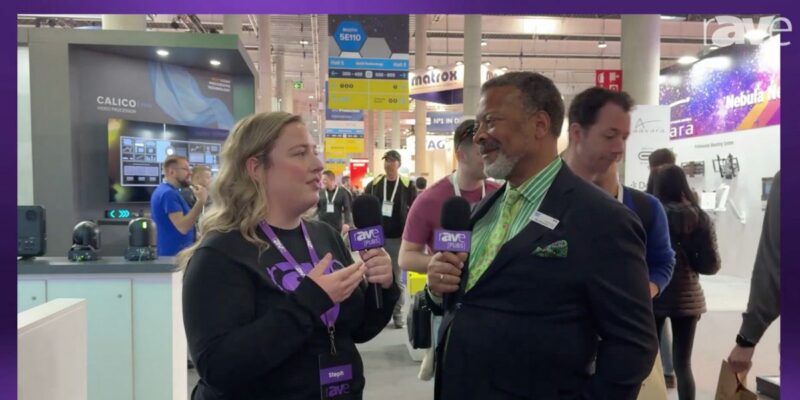InfoComm: Q&A With HDBaseT Alliance President Ariel Sobelman: What’s in Store for Pro AV
 HDBaseT was introduced to the market roughly five years ago. The idea behind the technology was to be able to transmit and distribute uncompressed high-definition AV content over the most cost-effective and prevalent medium possible — Cat5e cable — over distances unprecedented until then. HDBaseT makes it possible to transmit uncompressed ultra-high-definition AV (up to 4K), controls, Ethernet, USB 2.0 and up to 100 watts of power for up to 330 feet (100 meters). This is what the HDBaseT Alliance, a group of more than 130 companies, calls the 5Play feature set of HDBaseT, which is supposed to bring increased flexibility and simplicity to installations in all parts of the AV industry.
HDBaseT was introduced to the market roughly five years ago. The idea behind the technology was to be able to transmit and distribute uncompressed high-definition AV content over the most cost-effective and prevalent medium possible — Cat5e cable — over distances unprecedented until then. HDBaseT makes it possible to transmit uncompressed ultra-high-definition AV (up to 4K), controls, Ethernet, USB 2.0 and up to 100 watts of power for up to 330 feet (100 meters). This is what the HDBaseT Alliance, a group of more than 130 companies, calls the 5Play feature set of HDBaseT, which is supposed to bring increased flexibility and simplicity to installations in all parts of the AV industry.
On Jan. 6, the HDBaseT Alliance and IEEE announced the latter’s approval of HDBaseT Specifications 1.1.0 and 2.0 for adoption into the standards portfolio. I spoke with Ariel Sobelman, HDBaseT Alliance President and Valens’ Vice President of Corporate Alliances, about what this standard will mean for the AV industry. (Valens is the inventor of the HDBaseT technology.)
NM: What is the purpose of HDBaseT standardization?
AS: Standardization is essential to bring interoperability and flexibility to users and integrators. Without standardization, users would be locked in certain brands, without being able to mix and match for better suitability and fit and without the ability to future-proof installations without major investments. Standardization guarantees that every manufacturer has a set of basic specifications that must be followed for the benefit of the industry as a whole.
NM: What’s the plan and timeline for the IEEE Working Group?
AS: Since HDBaseT is an established technology, with very clear specifications, it is being adopted as a non-IEEE standard. That means that the process is much shorter than a standard that is created by IEEE from scratch. In our case, voting on the recommendation is expected by end of January, and final acceptance by the review committee by February.
NM: Describe a system that uses all five plays.
AS: Any AV product that consumes less than 100W of power can be designed as a 5Play system. During CES, we actually demonstrated an off-the-shelf product — the Aquavision ConnectTV Active 27-inch outdoor TV. It is a residential TV that supports all five plays — audio, video, Ethernet, controls, and power — allowing for installation anywhere in the home, without the need to have a power outlet nearby or an extension cord. The TV can be placed up to 330 feet away from any source. Television sets are using increasingly less amounts of energy to comply with Energy Star recommendations.
NM: What systems could benefit from HDBaseT the most?
AS: Anytime there is a demand for high-quality video distribution — uncompressed high-definition content — there is a fit for HDBaseT. HDBaseT’s usage of Cat cable means that installations are simpler, with cost-effective cabling that is easy to terminate in the field. In addition, it allows for distances between source and sink equipment, and an array of extra features not always supported by other means. Verticals that have benefited so far from HDBaseT include commercial installations, educational settings, residential/home set-ups, digital signage, healthcare, retail, hospitality and more.
NM: What does it mean for pro AV, i.e. videoconferencing/UCC, live events, healthcare AV?
AS: Let’s look at a practical example. In a hospital setup, you may have several screens around common areas, displaying practical information and/or soothing images and programs to calm patients. All these displays can be connected to each other and/or to a central server that can be placed in an out-of-the-way equipment room, without the need to duplicated sources, and for much simpler management of content. Another example would be a university, where the lecturer can control the content being displayed by the projector, whether it is in a central computer and/or server, or if it is in his or her personal computer. All connections — from the lecturer podium, from other sources, and to the projector — can be managed remotely, and run over a simple Cat cable.
NM: What will it mean to be HDBaseT standard-compliant?
AS: The HDBaseT Alliance runs a certification program, which expects manufacturers to submit their HDBaseT product for a certification test by a Recognized Testing Facility. The test verifies that the product has been developed according to the HDBaseT standard and determines which features are supported. This information is updated in real time on the Alliance website’s Certified Product List to promote interoperability and adherence to the standard.
NM: Does the standard support 4K at 60 Hz? If not, is it possible to accomplish it by other means?
AS: HDBaseT supports 4K at 60 Hz with chroma subsampling of 4:2:0. First products are already coming to the market. They have been shown at CES, and they will be shown at ISE and at InfoComm 2015.
NM: What is HDBaseT Alliance doing about product interoperability?
AS: Since its introduction to the market, HDBaseT technology conquered the market. There are hundreds of HDBaseT products in the market today, covering the full AV ecosystem, from extenders, to matrix/switches, projectors, displays and more. Our goal is to promote increased interoperability, by accelerating the rate of product certification, and introduction of these products in the Certified Product List. The more products that are certified, the more flexibility integrators and installers have in terms of interoperability.
NM: What about products that cover only two or three out of the five features and are marketed as HDBaseT products?
AS: One of the growing pains of HDBaseT has been that there are a lot of products that came into the market at a very quick pace and they are not all certified and did not all pass the certification process. That was because the explosive nature of HDBaseT was surprising to everyone, including ourselves. And then what happened was that we were not able to fully enforce the certification rule effectively at the beginning. That was a learning curve. So, it’s not an intrinsic problem of the standard.
There can be products that offer 4Play or 5Play, and 5Play is power. Not all products want to offer power at this stage — they may want to do it later, but not immediately — and the standard needs to allow them not to be in an all-or-nothing situation. So, that’s when we realized that interoperability depends on a massive certification and ensuring that everyone complies with the standard is certified. We understand the market’s concern on that and we’re addressing it with two things. One is very strict enforcement of certification rules and we’ve made many announcements over the last months to membership that, starting at the beginning of the year, we’ll be very strictly and vigorously enforcing certification rules. The immediate result of that has been that just over the last few months, there’s been a dramatic increase in the certified products. I think it went from a few dozen to 270 to 300 certified products. The second is how to educate and make all of the information transparent to the market so when installers, customers and vendors want to see what will interoperate with what and what will work, they will have a website with all these products that have very detailed listings of the feature sets and now will also have a mobile app that we’ll be announcing, which will show to the installers in real time, in the field, which of the five plays are supported. We have to make it clear: when you buy a product, make sure it’s certified.
NM: What are the future plans for HDBaseT given the potential of fiber proliferation, Internet of Everything and smart cities?
 AS: The HDBaseT Alliance keeps its finger on the pulse of the market, and we are constantly looking at the latest trends and directions in the sector. For example, the HDBaseT Alliance recognized that some verticals — such as medical and government/military — may prefer to use fiber infrastructure in their deployments. As such, Spec 2.0 of the standard also defines the usage of fiber as a transmission medium for the technology, allowing for AV, control, and Ethernet. Internet of Everything and smart cities takes transmission and distribution of high-definition multimedia content one step further. The Alliance is already looking at additional enhancements that will facilitate networking and empower IoE and other initiatives.
AS: The HDBaseT Alliance keeps its finger on the pulse of the market, and we are constantly looking at the latest trends and directions in the sector. For example, the HDBaseT Alliance recognized that some verticals — such as medical and government/military — may prefer to use fiber infrastructure in their deployments. As such, Spec 2.0 of the standard also defines the usage of fiber as a transmission medium for the technology, allowing for AV, control, and Ethernet. Internet of Everything and smart cities takes transmission and distribution of high-definition multimedia content one step further. The Alliance is already looking at additional enhancements that will facilitate networking and empower IoE and other initiatives.
HDBaseT Alliance was recently named an official InfoComm International Renewal Unit (RU) Provider. This allows CTS holders to earn RUs by completing the HDBaseT Alliance’s Installer Expert education programs. As part of their training program at Integrated Systems Europe 2015, Alliance will be offering 1.5 CTS RUs. Visit them at Hall 7, Booth No. 7E-190.
This interview was reprinted with permission from InfoComm and originally appeared here.





